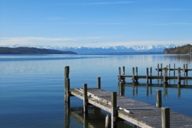
You can do everything – you don’t have to do anything. Isn’t that an appealing prospect for a day trip to the area around Starnberger See (lake)? Just half an hour’s journey by S-Bahn from Munich, you can embark on three wonderfully short, low-effort hiking and biking tours. Our author has already had the pleasure.
As I pull into Starnberg Station I can see a row of white mountains with the lake in front of them. God clearly created this as a place to spend that seventh day, planned for rest. People from Munich have been flocking to Starnberger See (lake) since time immemorial, seeking to infuse some of the grandeur of this setting into their own lives.
On this fine spring day I take the path towards the start of the hiking trail through the Maisinger Schlucht (gorge). The route first leads me away from the lake, which means I notice the Hotel Bayerischer Hof and a number of other historic buildings for the first time, opposite the train station on the road towards Starnberg: reminders of the era when this place was a rather swanky lakeside resort frequented by wealthy spa guests. At the turn of the 20th century, the keyword around here was “Sommerfrische” – summer resort – and today I can see the evidence in an entrance adorned with Art Nouveau floral embellishments, and above it the words: “Am stillen See sitz‘ ich und starre in ein gespiegeltes Paradies” (I sit by the still lake and gaze into a reflected paradise).
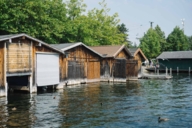
As soon as I cross the main thoroughfare it becomes very peaceful, almost village-like; the sound of twittering birds surrounds me – and will continue to do so for the rest of my hike. The path towards Maisinger Schlucht is well-defined and branches away on Söckinger Strasse.
This is not a route up to lofty altitudes, but rather to the murmuring stream and the knock-knock-knocking of a woodpecker. The sparse woodland here is dotted with yellow, white and purple from marsh marigolds and anemones. The further into the gorge I go, the steeper the banks on both sides of the stream become. The path passes through a few rocky stretches, and anyone who passes or comes towards me greets me with a friendly “Servus” (hi). I encounter one family sitting down on a tree trunk for a rest, as the children splash around enthusiastically in the stream. A camp set up by the river, building dens – it seems that the recipe for a child-friendly afternoon of fun actually hasn’t changed all that much.
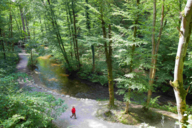
Then the gorge ends and the trail continues through Maising, where there are a number of lovely taverns. A few minutes later I reach Maisinger See, a lake which is a remnant from the Ice Age. It’s a great place for a summer swim, followed by a visit to the Maisinger Seehof beer garden. I treat myself to a lager and sit on one of the benches facing the water. This lake is a breeding ground and safe haven for various native bird species and migratory birds; I don’t spot any kingfishers this time, but there are lots of grey herons.
As I make my way back, walking through deciduous woodland past Söcking and on to Starnberg, I stop several times to let nature wash over me. The spring air here smells amazing. A small bird of prey shrieks overhead, then swoops down so low that I can see the sun shimmer through its wings. There’s a snow-white stoat scampering about the meadow opposite. I’ve never seen one of those before! Well, except in the form of ermine coats in portraits of the Bavarian kings.
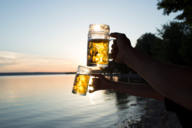
Back in Starnberg, before I make the journey home, I permit myself an ice cream and spend a good hour on the lake promenade, which is a little busier than it was earlier. And I discover that, yes, actually it’s a great way to describe it: I sit there and stare into a reflected paradise.
You can find details of this route and a great many other tours at:
www.starnbergammersee.de
I arranged to do this relaxing cycling route in summer with my sister – who refuses to participate in any gruelling mountain tours and does not appreciate the joy of reaching a summit. This seemed like more her thing: gently pedalling through forests and meadows, enjoying a leisurely bite to eat and then swimming in not one but three different lakes. Lakes Wesslingersee, Pilsensee and Wörthsee, together with the much larger lakes of Ammersee and Starnberger See, form the “Kulturlandschaft StarnbergAmmersee” (Starnberg/Ammersee culture landscape) – and we can certainly confirm that the route has some great cultural offerings.
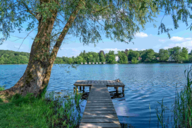
The hamlet of Wessling, where we begin our cycling tour at the S-Bahn station, gives a first impression of being rather unassuming, though it can actually boast several famous connections. Painters discovered this idyllic village as a subject for their works as far back as 1870; then, once the railway line to the village was complete, the people of Munich followed, heading to the Café am See to enjoy a chat or play cards. The view of the small lake at the heart of the village was painted by none other than Auguste Renoir, when he spent the summer here with his family in 1910.
Around the same time, psychiatrist Alois Alzheimer settled in Wessling while he worked in Munich, researching the disease he gave his name to. We lock our bikes up so that we can walk a little way along the waterside promenade and take a closer look at the famous neurologist’s country home.
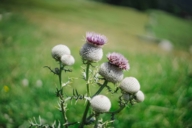
Then we get back to cycling, uphill and down, to Seefeld – where it seems that everything belongs to the old Bavarian aristocratic Toerrings family: the Count’s two named parking spaces in front of the castle, Schloss Seefeld (Seefeld Castle) itself, the Pilsensee lake at the foot of the family seat, woods and meadows in the surrounding area, as well as Wörthsee lake, the final stop on our journey.
My sister insists on a snack break in the Bräustüberl (traditional restaurant) in the former castle brewery, and makes it a typically Bavarian one by (ah, why not!) ordering a lager from the Toerring brewery to accompany it. Also here, in the former farmyard adjoining the brewery, is an array of studios, workshops and exclusive boutiques, some of which are also open at weekends. We covetously eye the jewellery on display in the Torbogen studio run by artist Nele Spari, before getting back on our bikes for the next leg.
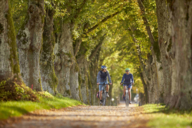
It takes less than ten minutes to cycle from the castle to the swimming area at Pilsensee lake, but the views along the way are positively jaw dropping. Our eyes are drawn past meadows, reed belts and wooden bridges to the lake and mountains beyond. The avenue of oak trees along what is now called Staatsstrasse stands as a monument to nature. It is one of the longest and most beautiful in Europe, and was the first avenue in Bavaria. The trees are thought to have been planted around 1770 (by the Toerrings!!!).
The lakeside swimming area is managed with a lot of love, and that comes through in the culinary offering – from the redcurrant soda to the delicious cakes, everything here is organic. One of the owners also offers Zumba lessons at sunset every Thursday. We splash around at length and then retreat to the shade of some mature trees to enjoy the sun glistening on the water and the idyllic view of the castle opposite.
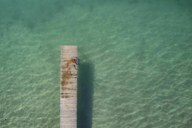
But we have saved the best till last: Wörthsee is my absolute favourite lake. The sight of the shimmering, turquoise water there makes me want to whoop with joy. It’s also true that Steineback and, a little higher up, the village of Walchstadt with its old farms would be my first choice of places to live if I were ever to leave Munich.
It would be perfect if I could have a little cottage in between the two places – with a view of the Alps. We do not let this incredible panorama out of our sight, even though that means deviating slightly from the route and going up a steeper hill than we are used to. We can make out the church spire of Andechs monastery in the distance.
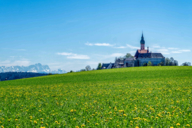
The standard tour follows the railway line and leads back to Wessling. But we’re not done here yet – we want to keep drifting on the water and looking at the sky, before heading to the Seehaus Raabe terrace to watch the stand-up paddlers and photograph our spritzers against the sun. Fortunately that is no problem, as the S-Bahn also travels back from Steinebach to Munich.
You can find details of this route and a great many other tours at:
www.starnbergammersee.de
I embark on the Ilkahöhe mountain hike at the end of February, with a lovelorn friend. We have plenty to talk about – and to avoid talking about – and so we are in absolutely no mood to follow a complicated route. That’s why we settle on Ilkahöhe, which can be easily reached in an hour from the train station at Tutzing. The hike to the top of the mountain requires minimal effort and yields maximum returns in the form of a stunning vista of Starnberger See lake and the Alps, from the Zugspitze mountain down to the Chiemgau area in the foothills. Some information for the geologically minded: standing some 726 m tall, Ilkahöhe was formed during the last Ice Age, from the moraine left behind by the Würm glaciers on the western bank of Starnberger See lake (known as Würmsee until 1962).
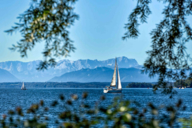
The mountain panorama creates a perfect backdrop to great conversation, punctuated by an occasional “It’s so beautiful here!”. Racking your brain to try and recall the name of this or that mountain is also a popular pastime up here – as ever, our attempts are somewhat wide of the mark, but it doesn’t bother us too much and it certainly bothers the mountains even less. They simply persist, in majestic indifference. We wander up and down wrongly naming various peaks before we collapse laughing onto one of the many benches.
Finally, we toast to love and friendship in the beer garden at the Forsthaus auf der Ilkahöhe restaurant. My friend says something like, “life must go on,” and orders some roast pork to confirm it.
We could have spent another half hour or so hiking to get to Deixlfurter See (lake) and then taken a roughly forty-five minute forest trail from there to Tutzing railway station. We could have, but like I said: you can do everything – but you don’t have to do anything.
You can find details of this route and a great many other tours at:
www.starnbergammersee.de